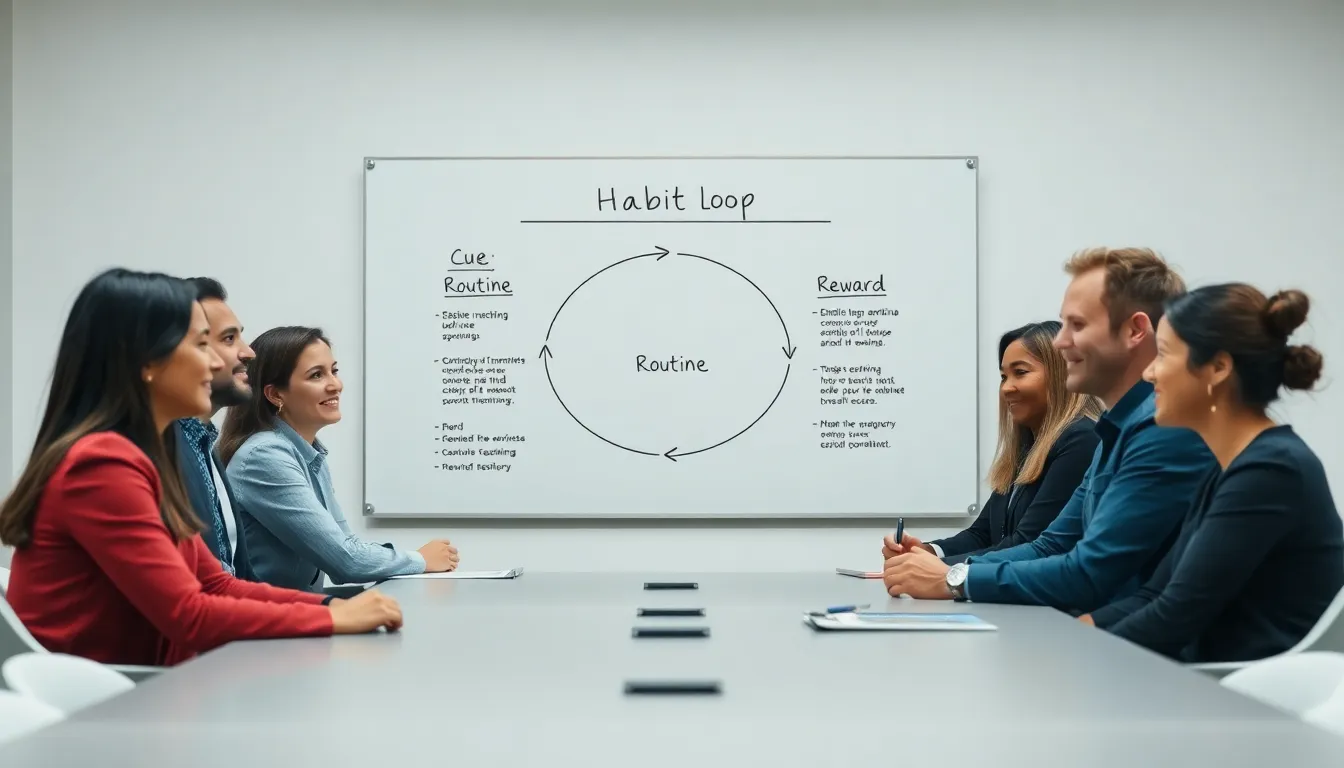Table of Contents
ToggleHabits shape our lives more than we realize. They’re the invisible forces driving our daily decisions, from that morning coffee ritual to the late-night snack runs. In “The Power of Habit,” Charles Duhigg uncovers the science behind why we do what we do and how we can harness this knowledge to transform our routines. Spoiler alert: it’s not just about willpower; it’s about understanding the habit loop.
Imagine turning your biggest goals into effortless routines. Whether it’s hitting the gym or finally tackling that novel, Duhigg’s insights reveal how small changes can lead to massive results. So, buckle up for a journey through the fascinating world of habits and discover how to rewrite your own story, one loop at a time. After all, who wouldn’t want to become the master of their own habits?
Overview of The Power of Habit
Duhigg’s “The Power of Habit” explores how habits shape actions and behaviors. It introduces the concept of the habit loop, which consists of three elements: cue, routine, and reward. By identifying these components, individuals can create meaningful changes in their routines.
Understanding cues enhances awareness of triggers that initiate habits. Recognizing the routine enables one to evaluate whether the action leads to a desired outcome. Replacing negative routines with positive ones serves as a strategy for improvement.
The book also discusses the role of willpower in habit formation. Research demonstrates that stronger willpower correlates with greater success in changing habits. Furthermore, Duhigg emphasizes the importance of belief in sustaining these changes. Believing in the ability to change fosters resilience against setbacks.
Studies in various environments highlight the impact of keystone habits. These habits have a disproportionate influence on overall behavior patterns. For example, exercise often leads to healthier eating and increased productivity.
Duhigg provides case studies from businesses and individuals, illustrating how understanding habits can drive transformation. Successful companies adapt their marketing strategies based on consumer habits. Individual stories demonstrate how small adjustments result in profound life changes.
By embracing these principles, readers gain insights into the power of habits. The potential to reshape daily routines awaits anyone ready to apply these strategies effectively.
Key Concepts in The Power of Habit


Understanding habits offers insights into behavior change. Several core concepts emerge from Duhigg’s exploration of habitual actions.
The Habit Loop
The habit loop forms the foundation of how habits work. It consists of three components: cue, routine, and reward. Cues trigger the habit process and can vary widely, from time of day to emotional state. Routines encompass the actions taken after the cue—these habits can be physical, mental, or emotional. Rewards provide the motivation to repeat the behavior, reinforcing it over time. By recognizing and altering specific elements within this loop, individuals can reshape their habits effectively.
The Role of Cue, Routine, and Reward
Cues initiate habits, serving as signals that prompt behavior. Routines represent the habitual actions taken in response to these cues, forming the core of behavior patterns. Rewards, whether intrinsic or extrinsic, create a feedback loop that encourages the repetition of routines. Effectively identifying cues leads to strategic interventions that alter routines and enhance rewards. This process highlights the importance of understanding each component for lasting habit change. Recognizing cues and rewarding positive change empowers individuals to take control of their habits.
Types of Habits
Understanding different types of habits enhances the ability to modify them effectively.
Keystone Habits
Keystone habits serve as foundational behaviors that can trigger a chain reaction of positive changes. These habits impact other routines, creating a domino effect in personal and professional lives. Examples include regular exercise, which can lead to improved eating habits and increased productivity. Identifying and cultivating keystone habits helps individuals focus on core areas, making it easier to create lasting transformations. Duhigg emphasizes these habits because their influence extends beyond the initial behavior, often improving self-discipline and goal attainment across various contexts.
Compound Habits
Compound habits result from the accumulation of small behaviors that, over time, yield significant results. When individuals consistently engage in minor actions, these actions build on each other, leading to substantial improvements in overall performance. For instance, saving a small amount of money daily can compound into significant financial security. Developing compound habits focuses on consistency and the collective impact of small changes. This approach demonstrates how gradual adjustments in daily routines can lead to remarkable achievements. Duhigg’s insights reinforce the importance of persistence in forming and sustaining these habits.
Strategies for Changing Habits
Strategies for changing habits often focus on understanding the elements that comprise the habit loop.
Identifying Cues and Routines
Recognizing cues is essential in transforming habits. Cues can be environmental, emotional, or social triggers that prompt specific behaviors. Individuals must observe their reactions to these cues to understand their routines better. For instance, someone may find that stress leads to unhealthy snacking. Identifying these patterns allows for a conscious evaluation of routines. They can then consider whether to replace detrimental routines with healthier alternatives, such as going for a walk instead of reaching for snacks. This awareness lays the groundwork for sustainable habit change.
Establishing New Rewards
Establishing new rewards significantly influences the likelihood of successfully adopting new habits. Rewards must be satisfying enough to reinforce the desired behavior. Individuals should assess which rewards resonate personally, be it a sense of accomplishment or small treats. For example, someone may enjoy a favorite book after completing a workout. Combing through various reward systems helps in identifying what truly motivates change. Ensuring that the rewards align with personal goals maintains enthusiasm and commitment. Effectively linking the new habits to enjoyable rewards fosters a positive feedback loop, encouraging persistence.
Real-Life Applications of Habit Change
Real-life applications of habit change span various aspects of life, demonstrating the practical impact of understanding habits.
Personal Growth
Personal growth often hinges on habit modification. Individuals can identify cues that trigger unproductive behaviors, enabling them to implement mindful routines. For example, recognizing stress as a cue for unhealthy snacking can lead to adopting healthier habits like preparing nutritious snacks in advance. They can also establish rewarding experiences tied to new behaviors. Incorporating enjoyable activities, such as daily meditation, reinforces positive changes and ensures sustainability. By focusing on keystone habits like regular exercise, individuals often experience a ripple effect, improving their overall well-being.
Business and Organizational Change
Businesses frequently leverage habit change to enhance productivity and culture. Organizations recognize the importance of habitual behaviors in their workforce. Analyzing existing routines can pinpoint inefficiencies, prompting the implementation of more effective practices. Leaders may encourage employees to replace habits that hinder performance with more constructive ones. For instance, creating a recognition program rewards employees for timely project completion, positively influencing motivation and engagement. By focusing on collective keystone habits, organizations often witness significant improvements in collaboration and innovation. A culture that embraces habit change ultimately drives organizational success and resilience.
Harnessing the power of habits can lead to profound changes in both personal and professional realms. By understanding the habit loop of cue, routine, and reward, individuals can identify and modify their behaviors effectively. The journey toward habit transformation requires persistence and a willingness to adapt.
Embracing keystone habits can trigger a cascade of positive changes, while recognizing cues and establishing meaningful rewards enhances the likelihood of success. Whether for personal growth or organizational improvement, the insights from “The Power of Habit” empower individuals to take control of their routines and reshape their lives. With mindful strategies and commitment, anyone can unlock their potential and achieve lasting transformation.







